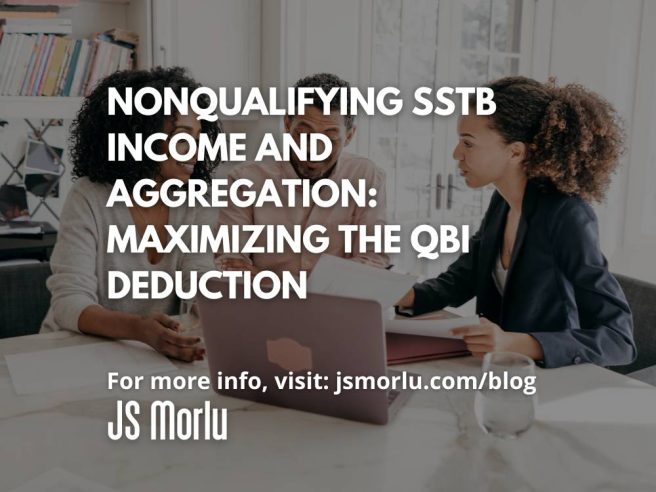By: John S. Morlu II, CPA
The Qualified Business Income (QBI) deduction under Section 199A offers valuable tax savings for eligible taxpayers, but certain rules apply to Specified Service Trades or Businesses (SSTBs) that complicate qualification. While SSTBs generally face limitations, exceptions exist for taxpayers with incomes below or within the phase-out threshold. Additionally, the ability to aggregate trades or businesses can further optimize the deduction.
Let’s explore how SSTB income exceptions work and how aggregation can benefit business owners.
Nonqualifying SSTB Income Exception
What is an SSTB?
Specified Service Trades or Businesses (SSTBs) include industries like health, law, accounting, and consulting. Income from SSTBs faces stricter rules for QBI deduction eligibility, especially for high-income taxpayers.
However, taxpayers with taxable incomes below or within the phase-out thresholds can still include SSTB income as QBI for calculating the deduction.
2024 Income Thresholds
For 2024, the QBI deduction thresholds are:
| Filing Status | Threshold | Phase-Out Upper Limit |
| Married Filing Jointly | $383,900 | $483,900 |
| Single or Other Filers | $191,950 | $241,950 |
If a taxpayer’s income falls:
1. Below the threshold: SSTB income is treated like any other qualified trade or business income, eligible for the full QBI deduction (up to 20%).
2. Within the phase-out range: SSTB income qualifies for a partial deduction, subject to wage and capital limitations.
3. Above the phase-out upper limit: SSTB income is not eligible for the QBI deduction.
How the Phase-Out Works
The phase-out applies gradually as taxable income exceeds the threshold. Let’s break it down with an example.
Example: SSTB Income with Partial Deduction
- Taxable Income: $458,900 (married filing jointly)
- QBI from SSTB: $30,000
- Phase-Out Percentage (POP): (458,900−383,900)÷100,000=75(458,900 – 383,900) ÷ 100,000 = 75%(458,900−383,900)÷100,000=75
| Step | Calculation | Result |
| 20% of QBI | $30,000 × 20% | $6,000 |
| SSTB Phase-Out (POP × QBI) | $30,000 × 75% | $22,500 |
| QBI Deduction | $30,000 – $22,500 | $7,500 |
- Key Takeaway: Taxpayers in the phase-out range receive a partial deduction. However, if income exceeds the phase-out limit ($483,900 in this case), the deduction is completely disallowed.
Wages and Capital in SSTBs
For SSTBs, the wages and capital test does not apply when taxable income falls within the phase-out range. Once taxable income exceeds the upper limit, no deduction is available, regardless of wages or capital investment.
Aggregation of Trades or Businesses
Aggregation allows taxpayers to combine multiple trades or businesses into a single unit for QBI deduction purposes. This can simplify calculations and maximize the deduction, especially for businesses with shared resources or operations.
Key Rules for Aggregation
1. Optional for Taxpayers:
Taxpayers may choose to aggregate businesses but are not required to do so.
2. Requirements for Aggregation:
Businesses can be aggregated if they meet the following criteria:
- They are under common ownership (50% or more common ownership, directly or indirectly).
- They share operational interdependence (e.g., providing goods or services to each other).
- They meet specific IRS regulations for grouping.
3. Binding Election:
Once a taxpayer elects to aggregate, the decision is binding for future years. The IRS requires annual reporting of the aggregation, including detailed information about the businesses.
4. Changes Allowed:
- New businesses can be added to an existing aggregated group.
- Businesses that no longer qualify can be removed.
Example of Aggregation Benefits
Scenario:
A taxpayer owns two businesses:
- Business A: Service-based business generating $200,000 in QBI, with $40,000 in W-2 wages and $300,000 in UBIA.
- Business B: Asset-heavy business generating $100,000 in QBI, with $10,000 in W-2 wages and $1,000,000 in UBIA.
If treated separately, Business B fails the wage and capital test due to low wages. However, aggregating the businesses allows the taxpayer to combine wages and UBIA for both entities, meeting the test.
| Step | Calculation | Result |
| Combined QBI | $200,000 + $100,000 | $300,000 |
| Combined W-2 Wages | $40,000 + $10,000 | $50,000 |
| 50% of W-2 Wages | $50,000 × 50% | $25,000 |
| 25% of W-2 Wages + 2.5% UBIA | ($50,000 × 25%) + ($1,300,000 × 2.5%) | $32,500 |
By aggregating, the taxpayer can utilize the higher wage and UBIA limits, maximizing the QBI deduction.
IRS Oversight
The IRS reserves the right to disaggregate trades or businesses if the taxpayer fails to meet reporting requirements. Accurate and timely filings are essential to maintain aggregation benefits.
Key Takeaways
1. SSTB Income Can Qualify:
Taxpayers with incomes below or within the phase-out range can include SSTB income in their QBI deduction calculations. However, the deduction phases out entirely for those above the upper limit.
2. Aggregation Maximizes Deductions:
Combining related businesses can help meet wage and capital tests, increasing the allowable QBI deduction.
3. Careful Tax Planning is Essential:
Whether dealing with SSTB income or aggregation, taxpayers should work with a tax professional to ensure compliance and maximize tax savings.
Conclusion
The rules surrounding SSTB income and aggregation provide opportunities for maximizing the QBI deduction, but they require careful navigation. By understanding the phase-out thresholds, leveraging aggregation when appropriate, and maintaining compliance with IRS requirements, taxpayers can make the most of this significant tax benefit.
Author: John S. Morlu II, CPA
John S. Morlu II, CPA, is the CEO and Chief Strategist of JS Morlu, a globally acclaimed public accounting and management consulting powerhouse. With his visionary leadership, JS Morlu has redefined industries, pioneering cutting-edge technologies across B2B, B2C, P2P, and B2G landscapes.
The firm’s groundbreaking innovations include:
• ReckSoft (www.ReckSoft.com): AI-driven reconciliation software revolutionizing financial accuracy and efficiency.
• FinovatePro (www.FinovatePro.com): Advanced cloud accounting solutions empowering businesses to thrive in the digital age.
• Fixaars (www.fixaars.com): A global handyman platform reshaping service delivery and setting new benchmarks in convenience and reliability.
Under his strategic vision, JS Morlu continues to set the gold standard for technological excellence, efficiency, and transformative solutions.
JS Morlu LLC is a top-tier accounting firm based in Woodbridge, Virginia, with a team of highly experienced and qualified CPAs and business advisors. We are dedicated to providing comprehensive accounting, tax, and business advisory services to clients throughout the Washington, D.C. Metro Area and the surrounding regions. With over a decade of experience, we have cultivated a deep understanding of our clients’ needs and aspirations. We recognize that our clients seek more than just value-added accounting services; they seek a trusted partner who can guide them towards achieving their business goals and personal financial well-being.
Talk to us || What our clients says about us




